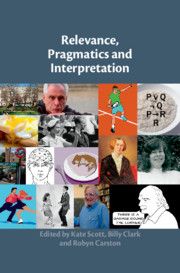Book contents
- Relevance, Pragmatics and Interpretation
- Relevance, Pragmatics and InterpretationEssays in Honour of Deirdre Wilson
- Copyright page
- Contents
- Contributors
- Cover Acknowledgements
- Introduction
- Reflections on the Development of Relevance Theory
- Part I Relevance Theory and Cognitive Communicative Issues
- Part II Pragmatics and Linguistic Issues
- Part III Figurative Language and Layered Interpretations
- 15 Metaphor and Metonymy in Acquisition
- 16 Relevance and Metaphor Understanding in a Second Language
- 17 Component Processes of Irony Comprehension in Children
- 18 Allegory in Relation to Metaphor and Irony
- 19 Slave of the Passions
- 20 Adaptations as Communicative Acts
- References
- Author Index
- Subject Index
15 - Metaphor and Metonymy in Acquisition
A Relevance-Theoretic Perspective
from Part III - Figurative Language and Layered Interpretations
Published online by Cambridge University Press: 08 July 2019
- Relevance, Pragmatics and Interpretation
- Relevance, Pragmatics and InterpretationEssays in Honour of Deirdre Wilson
- Copyright page
- Contents
- Contributors
- Cover Acknowledgements
- Introduction
- Reflections on the Development of Relevance Theory
- Part I Relevance Theory and Cognitive Communicative Issues
- Part II Pragmatics and Linguistic Issues
- Part III Figurative Language and Layered Interpretations
- 15 Metaphor and Metonymy in Acquisition
- 16 Relevance and Metaphor Understanding in a Second Language
- 17 Component Processes of Irony Comprehension in Children
- 18 Allegory in Relation to Metaphor and Irony
- 19 Slave of the Passions
- 20 Adaptations as Communicative Acts
- References
- Author Index
- Subject Index
Summary
Ingrid Lossius Falkum uses data from young children’s communicative development to argue that metaphor and metonymy rely on different pragmatic mechanisms. Metaphor and metonymy do have certain characteristics in common: they both target individual words or phrases, they both contribute content to the proposition explicitly expressed, and they both lie on a continuum of literal and figurative uses. However, developmental data suggests that early metonymic uses may be the result of a more basic process than metaphorical uses, one in which the child exploits salient associative relations to compensate for gaps in vocabulary.
Keywords
- Type
- Chapter
- Information
- Relevance, Pragmatics and Interpretation , pp. 205 - 217Publisher: Cambridge University PressPrint publication year: 2019
- 10
- Cited by

